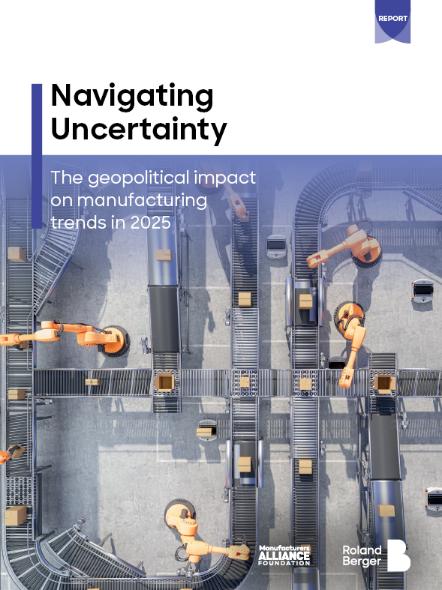Practical advice on navigating challenges and exploiting growth opportunities in material handling and warehouse automation.


Manufacturers reassess strategy amid geopolitical uncertainty
By Gareth Hayes
New report reveals how leading companies are shifting from growth to resilience in 2025
A new study, conducted in collaboration with the Manufacturers Alliance, reveals that 94% of manufacturing executives say tariff uncertainty is delaying investment decisions.
The geopolitical tensions of 2025 are reshaping strategic priorities across the U.S. industrial landscape. Roland Berger’s latest study, "Navigating Uncertainty: The Geopolitical Impact on Manufacturing Trends in 2025," shows that manufacturers are rethinking their global footprints, capital investment strategies, and talent pipelines to remain competitive in an increasingly unpredictable world.

A new phase: From growth mode to resilience mode
After years of investment-driven growth, manufacturers are facing a new strategic reality. Trade tensions, unstable tariff regimes, and decoupling between global economies have forced many companies to put large-scale expansions on hold. According to the study, 90% of manufacturers report that geopolitical risk is slowing or stalling long-term development plans. Almost all respondents (94%) cite tariff uncertainty as a significant factor impacting sourcing and capital allocation decisions.
This research, co-authored by Roland Berger and the Manufacturers Alliance, is based on a quantitative survey of more than 150 senior executives from U.S.-based manufacturing companies, along with in-depth interviews with over 20 CEOs. Industries represented include machinery, electronics, chemicals, food processing, and plastics.
The data reveals a strategic pivot from globalization and cost efficiency to regionalization, agility, and risk mitigation. Manufacturers are increasingly adopting strategies aimed at building resilience in the face of external shocks.
Explore how geopolitical shifts are also impacting the future of material handling .
Six trends shaping manufacturing in 2025
- Capital-light localization strategies gain ground - As companies pull back from significant greenfield investments, “capex-light” approaches are taking hold. Instead of building entirely new facilities, manufacturers are repurposing existing infrastructure or forming regional partnerships to localize operations more efficiently.
- Shift to politically stable markets over low-cost hubs - Executives expressed a clear shift in preference away from low-cost countries, such as China and Mexico, and toward stable, rule-of-law economies, including the United Kingdom and Japan. While these locations may carry higher operating costs, they offer infrastructure reliability, governance transparency, and reduced risk of supply chain disruption.
- Workforce disruption intensifies the skills gap - 83% of respondents expect workforce challenges to worsen over the next five years due to geopolitical risk. As a result, companies are doubling down on workforce development, from training academies to automation.
- Digitalization is accelerating as a resilience lever - Leading manufacturers are more than twice as likely to cite digital transformation as a core part of their response. Companies are embracing digital twins, predictive maintenance, and AI-driven planning to hedge against disruption.
- Customization and regionalization fuel product strategy - Nearly three-quarters (72%) of manufacturers report growing emphasis on market-specific product development. Regional product platforms and local engineering are crucial tools for efficiently meeting demand.
- Sustainability investments face pressure, but remain essential - While short-term geopolitical distractions are delaying some ESG spending, companies with sustainability embedded in their model are staying the course. Sustainability remains a strategic differentiator.
Strategies for success in an age of uncertainty
Despite mounting challenges, manufacturers have a window of opportunity to strengthen their market position. The report identifies three common strategies among outperforming companies:
- Build flexibility into product portfolios and capacity planning
- Align supply chains with regional demand profilesInvest in enabling technologies that reduce vulnerability to shocks
"Manufacturers are shifting from expansion to resilience. Flexibility, regionalization, and digitalization are now top priorities."
About the research
This study is the second installment in a multi-part series co-authored by Roland Berger and the Manufacturers Alliance examining how global disruption is reshaping the U.S. manufacturing landscape. It combines quantitative analysis from a survey of over 150 senior executives with in-depth interviews across multiple sectors, including machinery, electronics, chemicals, and food.
About Manufacturers Alliance
The Manufacturers Alliance is a peer-powered network that supports leadership development and operational excellence across the industrial sector. Its 501(c)(3) Foundation provides independent research and insights to help manufacturers navigate today’s most complex challenges. Learn more at manufacturersalliance.org.
Register now to access the full study and explorenew strategies to navigate manufacturing uncertainty effectively. Furthermore, you get regular news and updates directly in your inbox.




